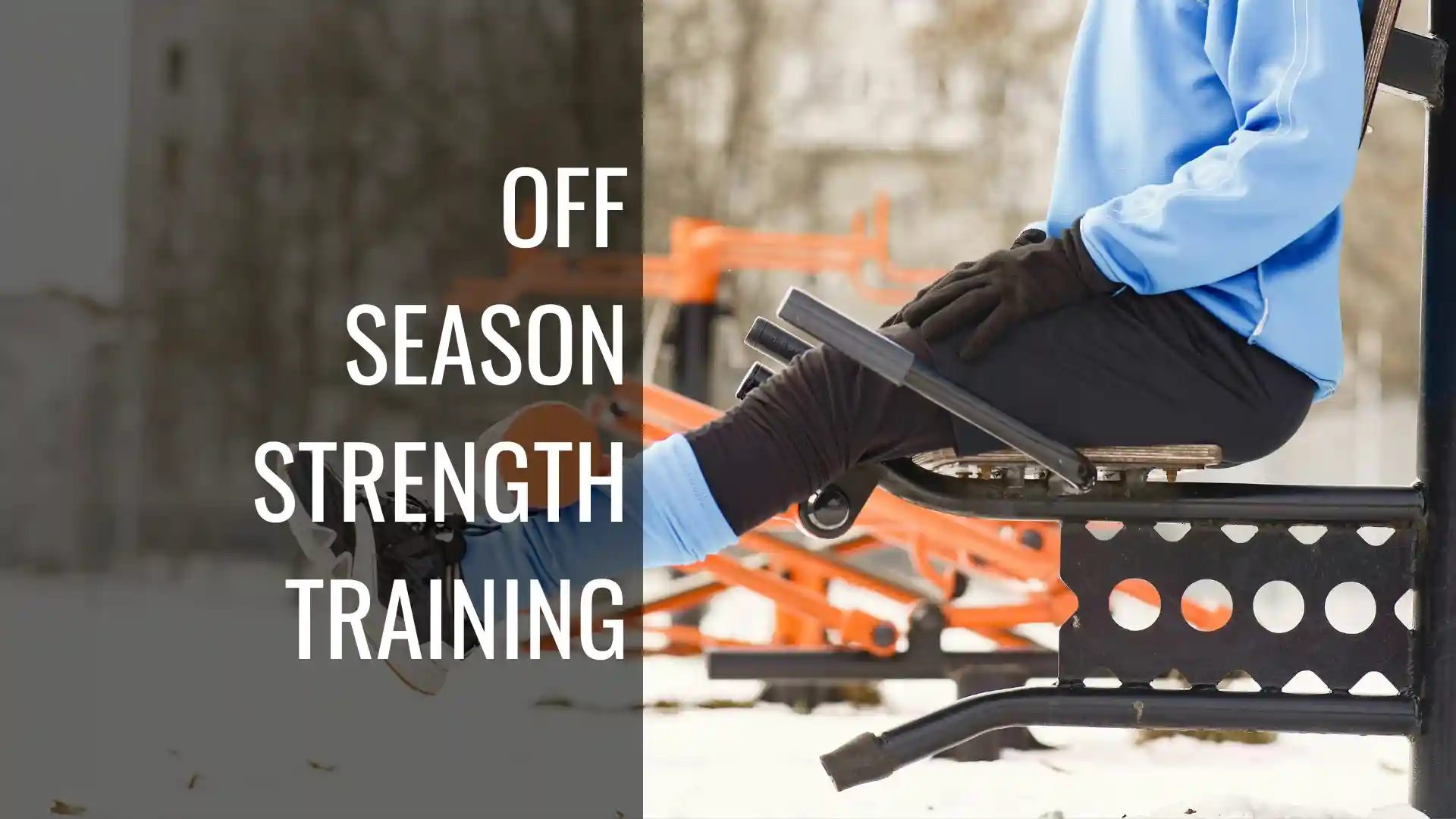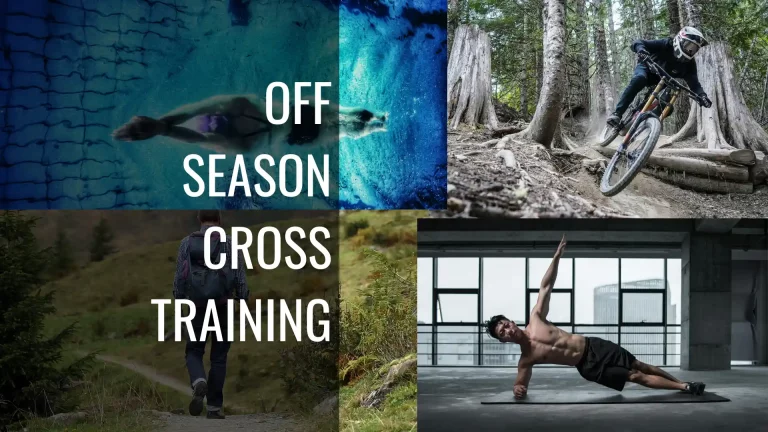
The off-season. For many cyclists, it’s a time to kick back, recover, and dial back the intensity. But this period is actually the most crucial window for building the foundation that will make you faster, more powerful, and more durable when spring rolls around. The off-season represents your greatest opportunity to address the physical limitations that hold you back on the bike. While your competitors are losing fitness on the couch, you can be in the weight room building the strength foundation that will translate directly to watts, speed, and endurance when racing season returns.
This comprehensive guide to off-season strength training for cyclists will walk you through everything you need to know about building cycling muscle during the cooler months
What you’ll learn in our off-season cycling strength training guide:
- Why your training program structure matters
- How to limit cold-weather injuries
- How to maintain strength gains as you return to serious riding
Whether you’re a seasoned racer or a dedicated recreational cyclist, the strategies in this article will help you return to the bike stronger and more resilient.
PEDAL MY WAY NEWSLETTER
Weekly training tips, cycling strategies, and fitness insights for sustainable performance.
No spam—just actionable guidance to help you train smarter.
Table of Contents
Why Strength Training Matters During Your Cycling Off Season
The off-season isn’t just a break from cycling – it is the optimal time to build a strength reserve that directly translates to on-bike performance and resilience, that will make you faster, more powerful, and more resilient when spring arrives. Strength training during this crucial period addresses the limitations that pure cycling can’t fix. While time in the saddle builds cardiovascular fitness and cycling-specific endurance, it doesn’t develop maximum force production or address the muscle imbalances that accumulate from thousands of pedal strokes in a fixed position.
Research consistently shows that cyclists who incorporate strength training improve their power output, sprint performance, and time trial capabilities. But perhaps more importantly, strength work enhances your body’s ability to withstand the repetitive stress of cycling. Stronger muscles, tendons, and connective tissues mean fewer overuse injuries and better durability over long seasons. The off-season gives you the recovery time needed to adapt to heavy loads without compromising your riding, making it the perfect window to build strength that will translate directly to watts on the bike.
Strength training in general improves cycling performance, such as –
- Boost Power and Speed: Strength training, particularly heavy lifting, improves muscle fiber recruitment, leading to greater maximum power output (sprinting, climbing).
- Improve Cycling Economy: A stronger musculoskeletal system is more efficient, reducing energy wasted through muscle stabilization and poor form, allowing you to ride faster for the same effort.
- Injury Prevention and Durability: Strength work addresses muscle imbalances, strengthens connective tissues, and builds bone density—all crucial for career longevity and staying healthy on the bike.
- Preserve Muscle Mass: As we age, resistance training is key to maintaining muscle mass, which often correlates with a faster metabolism and better overall health.
Building a Foundation: Core Exercises Every Cyclist Needs
Your core is far more than just your abs—it’s the critical link between your upper and lower body that stabilizes your position and transfers power to the pedals. It prevents excessive movement (rocking/swaying) on the bike, which wastes energy. The key muscles to target are Transversus Abdominis (deep stabilizers), Obliques, Erector Spinae (lower back), and Glutes. A strong core prevents energy leaks, maintains efficient positioning during long rides, and protects your lower back from the sustained flexion of the cycling position.
Start with anti-movement exercises that teach your core to resist unwanted motion. Planks and dead bugs build basic stability, but progress to more challenging variations like Pallof presses, which force your core to resist rotation. Bird dogs develop coordination between opposite limbs while challenging spinal stability. Don’t overlook anti-extension work like ab wheel rollouts or body saws, which directly address the anterior core strength needed to maintain position during hard efforts.
Rotational exercises like cable chops and medicine ball throws develop the power transfer needed during out-of-saddle climbing and sprinting. Include loaded carries—farmer’s walks and overhead carries—which build real-world core strength under dynamic conditions. Aim for 2-3 dedicated core sessions per week, focusing on quality of movement rather than burning sensations. Your core should feel challenged but not destroyed, as these muscles need to function during every ride.
Remember the go-to Exercises:
Planks (and variations): Front and Side Planks for static stability.
- Dead Bugs: Excellent for anti-extension and deep core engagement.
- Bird-Dog: Promotes spinal stability while engaging the glutes and lower back.
- Paloff Press: Targets anti-rotation strength, crucial for stability when riding out of the saddle.
Lower Body Power: Squats, Lunges, and Leg Press for Cyclists
Lower body strength work forms the cornerstone of any cyclist’s off-season program. These exercises build the raw force production that translates directly to pushing bigger gears and accelerating harder. Back squats remain the gold standard—they develop overall leg strength through a full range of motion while demanding core stability and coordination. Start conservatively, focusing on depth and control before adding significant load. Work toward squatting at least your body weight for multiple reps by season’s end.
Front squats shift emphasis slightly forward, targeting the quadriceps more directly while demanding better mobility and upright posture. They’re particularly valuable for cyclists who struggle with forward knee travel or want to develop the specific quad strength used in time trialing positions. Bulgarian split squats bridge the gap between bilateral and unilateral work, building single-leg strength while allowing meaningful load.
The leg press serves a specific purpose in a cyclist’s program—it allows you to move heavy weights while minimizing lower back stress. Use it to build pure leg strength during phases when you’re already accumulating fatigue from other exercises. Focus on walking lunges and reverse lunges to develop strength through movement patterns that challenge balance and stability. Include both heavy, lower-rep work (3-5 reps) for maximum strength and moderate-rep ranges (6-10 reps) for hypertrophy and work capacity.
These compound movements are the bedrock of a cyclist’s strength program. Try to mix them in during your off season training (and even on conditioning days during cycling season)
Squats (Back/Front/Goblet): Target quads, hamstrings, and glutes simultaneously, building overall leg strength and power.
Lunges (Forward/Reverse): Excellent for working the muscles unilaterally (one leg at a time), which mimics the pedaling action and helps address side-to-side strength discrepancies.
Leg Press: A machine exercise that is effective for building high force and muscle size, especially in the quads, without the high technical demand of a heavy barbell squat.
Focus: In the off-season, focus on heavy, low-rep sets (e.g., 3−5 sets of 4−8 reps) to maximize force production gains.
Upper Body Strength: Don't Neglect Your Arms and Shoulders
Many cyclists mistakenly view upper body training as unnecessary weight that must be carried uphill. This perspective ignores the critical role your upper body plays in bike handling, sprinting, climbing, and maintaining position during long rides. A strong upper body stabilizes your position on the bike, allowing your legs to produce maximum power without your torso collapsing or swaying.
Focus on horizontal and vertical pulling movements to counterbalance the forward-hunched cycling position. Rows, pull-ups, and lat pulldowns strengthen the muscles that support your spine and shoulders during hours in the drops. These exercises help prevent the rounded shoulder posture and thoracic stiffness that plague many cyclists. Include various rowing angles—bent-over rows, single-arm rows, and cable rows—to develop complete back strength.
Pressing movements balance your pulling work and build the arm and shoulder strength needed for out-of-saddle efforts and technical handling. Push-ups, overhead presses, and bench variations all have merit, but prioritize movement quality over maximum loads. Your goal isn’t bodybuilder strength but functional capacity that supports your cycling. Keep rep ranges moderate (8-12 reps) and include 2-3 upper body sessions weekly. Don’t neglect grip strength either—dead hangs and farmer’s walks build the hand and forearm endurance needed for long gravel rides and maintaining hood position during endurance events.
A strong upper body provides stability and control, especially during sprints, climbs out of the saddle, and technical handling.
- Pulls (Back/Biceps):
- Bent-Over Rows or Seated Cable Rows: Strengthen the upper back, improving posture and resisting the urge to slump forward on the bike.
- Pull-Ups/Lat Pulldowns: Essential for overall back and arm strength.
- Pushes (Chest/Shoulders/Triceps):
- Push-Ups or Bench Press: Improve chest and triceps strength for stabilizing the handlebars.
- Overhead Press: Strengthens shoulders for better bike handling and holding an aero position.
Targeted Shoulder/Scapular Work: Exercises like Face Pulls are crucial for strengthening the rotator cuff and stabilizing the shoulder blades.
Periodization: How to Structure Your Off-Season Training Program
Effective off-season strength training follows a logical progression that builds capacity systematically. Cycling periodization phases are a systematic and structured approach to training that involves breaking down the cycling season into distinct phases or cycles, each with specific goals and training focus.
Start with an anatomical adaptation phase focused on movement quality, building work capacity, and preparing tissues for heavier loads. Use lighter weights for higher reps (12-15), emphasize proper form, and include a variety of exercises to address weaknesses. This phase builds the foundation that allows productive training later.
Progress into a maximum strength phase where loads increase significantly and reps decrease. This is where you build raw force production capacity. Focus on compound movements like squats, deadlifts, and presses with adequate rest between sets (3-4 minutes). You’ll feel fresher during this phase since training volume decreases even as intensity rises.
Transition to a power conversion phase as you approach the season. Shift toward explosive movements, plyometrics, and lighter loads moved quickly. Box jumps, jump squats, and medicine ball throws teach your nervous system to produce force rapidly. This phase bridges the gap between gym strength and on-bike power.
Throughout these phases, maintain 2-3 strength sessions weekly. Early season might support more frequent training, but reduce to 1-2 sessions as riding volume increases. Always allow at least 48 hours between lower body strength sessions and hard riding efforts to ensure adequate recovery.
A smart program follows a progression to maximize gains and ensure you peak on the bike, not in the weight room.
Phase 1: Adaptation (Wks 1-3): Focus on light weight, high reps (e.g., 3×12−15) to learn movements and build muscle endurance.
Phase 2: Hypertrophy (Wks 4-8): Increase the volume and move to moderate weight, mid-range reps (e.g., 3×8−12) to build muscle mass.
Phase 3: Max Strength/Force (Wks 9-12): Focus on heavy weight, low reps (e.g., 3−5×3−6) to build pure strength and neurological efficiency. This is the peak strength phase.
Phase 4: Conversion/Maintenance (Leading into Season): Transition to lower-volume, higher-velocity work (e.g., explosive exercises, light-weight speed squats) to translate gym strength into cycling power.
Preventing Injuries Through Targeted Strength Work (can link to target muscle app)
The repetitive nature of cycling creates predictable patterns of overuse and imbalance. Strategic strength training addresses these vulnerabilities before they become injuries. Focus on exercises that strengthen commonly weak areas in cyclists: glute medius, hip external rotators, and posterior chain muscles that become dominated by quad-heavy pedaling.
Clamshells, banded walks, and hip thrusts specifically target glute medius and maximus—muscles critical for pelvic stability but often underdeveloped in cyclists. Weak glutes lead to knee valgus, IT band issues, and lower back pain. Include Nordic hamstring curls or single-leg Romanian deadlifts to build hamstring strength and reduce the quad-to-hamstring strength ratio that predisposes cyclists to strains.
Address ankle mobility and calf strength through exercises like single-leg calf raises and ankle mobility drills. Strong, mobile ankles improve pedaling efficiency and reduce Achilles tendon stress. For knee health, include terminal knee extensions and step-downs that strengthen the VMO and improve patellar tracking.
Consider using targeted apps or resources that help identify and address your specific muscle imbalances. Regular movement screening can reveal asymmetries before they cause problems, allowing you to incorporate corrective exercises proactively rather than reactively.
A structured program helps address the common issues of a static cycling position.
Target Areas: Hips, glutes, and lower back are most vulnerable.
Exercises: Glute bridges, hamstring curls, and back extensions can specifically strengthen the posterior chain.
Tip: Incorporate exercises that increase hip mobility and flexibility to counteract the constant flexion of cycling.
Single-Leg Exercises to Correct Muscle Imbalances
Cycling creates subtle but significant strength differences between legs—one leg typically dominates, leading to power imbalances and compensation patterns that increase injury risk. Single-leg training exposes and corrects these asymmetries while building the unilateral strength and stability that directly transfers to the independent action of pedaling.
Start with single-leg Romanian deadlifts, which challenge balance while building hamstring and glute strength through a cycling-relevant hip hinge pattern. Progress from bodyweight to kettlebell or dumbbell variations. Step-ups onto a box build single-leg strength through a complete range of motion while eliminating the ability to push off with your non-working leg—a common cheat in bilateral exercises.
Pistol squats (or their easier progressions using a TRX or box) develop remarkable single-leg strength and mobility. Most cyclists need significant progression work before achieving full pistol squats, but the journey builds valuable capacity. Split squats and Bulgarian split squats allow heavier loading while maintaining unilateral focus.
Include single-leg leg press and single-leg extensions to safely expose strength differences with controlled movements. Always start your working sets with your weaker leg and match reps with your stronger leg—never exceed what your weak side can accomplish. Over weeks and months, you’ll notice the strength gap closing and your pedal stroke becoming more balanced. Dedicate at least one exercise per lower body session to single-leg work.
Cycling is a unilateral sport (each leg pedals independently). Single-leg movements are critical for balanced strength development.
Single-Leg Squats (Pistol Squat variations): High strength demand, excellent for balance and power.
Bulgarian Split Squats (Rear-Foot Elevated): A staple for identifying and correcting strength differences between legs, highly specific to cycling muscles (quads, glutes).
Single-Leg Romanian Deadlifts (RDLs): Crucial for strengthening the hamstrings and glutes while improving balance.
How Many Days Per Week Should Cyclists Lift Weights?
The optimal strength training frequency depends on where you are in your off-season and your training history. Complete beginners to strength training should start with 2 full-body sessions weekly, allowing ample recovery between sessions. This frequency builds consistent technical proficiency while managing fatigue effectively.
Experienced lifters, during the deep off-season, can handle 3-4 sessions weekly using an upper/lower split or a full-body approach with varied emphasis each day. For example: Monday (lower body emphasis), Wednesday (upper body emphasis), Friday (full body with lighter loads), and optional Saturday (accessory and core work). This frequency maximizes strength gains when riding volume is minimal.
As spring approaches and riding volume increases, reduce to 2 sessions weekly focused on maintaining strength rather than building it. Position these sessions strategically—avoid heavy leg work the day before or after hard interval sessions. Many cyclists successfully lift on the same day as their hard rides (after the ride) to preserve full rest days for recovery.
Listen to your body’s recovery signals. Persistent soreness, declining performance, or increased resting heart rate indicate inadequate recovery. It’s better to do two quality sessions weekly than four mediocre ones that leave you chronically fatigued. The off-season is long enough to build significant strength with patient, consistent training.
The frequency changes with the training phase. The following is a sample that you can start with and change as needed.
Off-Season/Base Phase: 2−3 full-body sessions per week are recommended for maximal strength gains. Ensure at least one rest day between sessions.
In-Season/Competition Phase: Reduce to 1 (or a maximum of 2) maintenance session per week. The goal is to retain the strength gains without compromising on-bike performance or recovery.
Transitioning Back to the Bike: Maintaining Strength Gains in Spring
The transition from off-season to regular cycling/ on road cycling/ racing season requires careful planning to maintain your hard-earned strength without compromising cycling fitness. Abruptly abandoning the weight room wastes months of work—strength gains fade within weeks without maintenance stimulus. Instead, shift your strength work from building to maintaining mode.
Reduce strength training to 1-2 sessions weekly as riding volume climbs. Maintain intensity (load on the bar) but reduce volume significantly—one or two heavy sets per exercise maintains strength effectively. Focus on your key compound movements: one squat variation, one hinge pattern, one pull, and one push. This minimal effective dose preserves strength without creating excessive fatigue.
Schedule maintenance sessions strategically around your key rides. Lift after hard ride days rather than before, or place sessions after easy recovery rides. Never lift heavy the day before intervals, races, or important rides. Some cyclists successfully maintain strength with one weekly session done immediately after their hardest ride of the week.
Monitor performance markers closely during this transition. If your power numbers decline or you feel persistently fatigued, you’re likely combining strength and cycling stress poorly. Adjust by reducing sets, increasing recovery days, or temporarily dropping intensity. Remember that maintaining strength requires far less work than building it—one focused session weekly can preserve most of your off-season gains throughout the racing season.
The transition phase is where gym strength is converted into cycling-specific power. A quick checklist below:
Phase-Out Heavy Lifting: Gradually reduce the volume and frequency of heavy lifting.
Incorporate Explosive Work: Introduce plyometrics (e.g., box jumps, jump squats) and strength-speed work to prime the nervous system for fast muscle contractions.
On-Bike Strength: Integrate high-torque, low-cadence (SFRs – Slow Force Repetitions) intervals on the bike to bridge the gap between gym strength and pedaling force.
Common Mistakes Cyclists Make in the Weight Room
As important is planning the strength session is, avoiding these pitfalls ensures a productive, injury-free off-season.
- Listen to your Body: The most prevalent mistake cyclists make is treating the gym like the bike—pushing through fatigue, training to failure, and equating suffering with effectiveness. Strength training demands fresh nervous systems and quality movement patterns. Stop sets short of failure, especially on compound lifts, to maintain technical precision and avoid excessive fatigue that compromises recovery.
- Progressive Overloading: Many cyclists neglect progressive overload, performing the same weights for the same reps week after week. Your body adapts to specific demands—if those demands don’t increase, neither does your strength. Track your workouts and systematically increase load, reps, or volume every 1-2 weeks. Even small progressions (adding 5 pounds or one rep) accumulate into significant strength gains.
- Ego Lifting: Ego lifting derails progress and causes injuries. Using weights too heavy to control properly teaches poor movement patterns and stresses joints rather than muscles. Master movement patterns with lighter loads before progressing. If you can’t complete a rep with good form, the weight is too heavy regardless of what others are lifting.
- Proper Planning: Poor exercise selection wastes time on movements that don’t transfer to cycling. Prioritize compound movements that build real strength over isolation exercises that create impressive pumps. While leg extensions and curls have roles as accessories, they shouldn’t form the core of your program. Build your sessions around squats, hinges, rows, and presses.
- Recovery: Finally, cyclists often ignore recovery needs, stacking hard rides and heavy lifting without adequate rest. Strength training and cycling both stress your body—they share the same recovery resources. Plan rest days, prioritize sleep, and fuel appropriately. The adaptations you seek happen during recovery, not during the training itself. Respect the process and your body will reward you with significant performance gains when spring racing arrives.
Skipping Warm-ups/Cool-downs: Cold muscles are prone to injury. Always include dynamic warm-ups and post-lift stretching.
Poor Form Over Heavy Weight: Prioritizing ego (lifting heavy) over technique is the fastest way to get injured. Start light, master the form.
Neglecting the Upper Body/Core: Focusing only on the legs leads to an imbalanced body that is less stable and more prone to fatigue on long rides.
Training to Failure Too Often: For endurance athletes, frequent training to muscle failure significantly hinders recovery and can negatively impact on-bike sessions. Leave a few reps in the tank.
Stopping Strength Training In-Season: Strength gains are rapidly lost. Even one maintenance session per week is necessary to preserve your off-season work.
Your Stronger Season Starts Now
The mileage you log in the off-season is important, but the time you spend under a barbell or on a mat will provide a greater return on investment for your speed and longevity. The off-season is your window of opportunity—a time when you can make transformative changes to your physical capabilities without compromising your riding. The cyclists who emerge strongest in spring aren’t those who simply rest or maintain base miles; they’re the ones who strategically built strength, addressed weaknesses, and created a more resilient body during the months when racing pressure was off.
Strength training is your long-term insurance policy against injury and performance plateau. By following a strategic, periodized program this winter, you’ll enter the cycling season not just recovered, but genuinely stronger, more stable, and more efficient. So, don’t let the weather be an excuse to slack off. Treat the gym as your secret weapon, and be ready to feel the unmistakable difference the next time you drop the hammer on the open road.
Happy Training!
Related Off-Season Cycling Training Posts
We also offer our Ask The Pedalist podcast, where we discuss common cycling topics.





